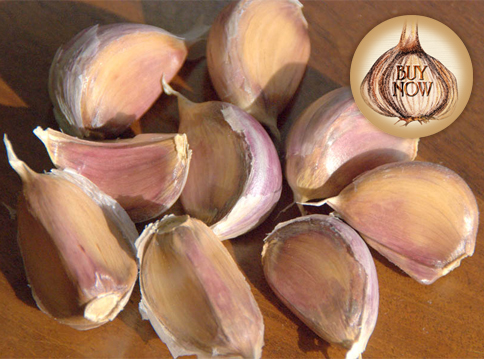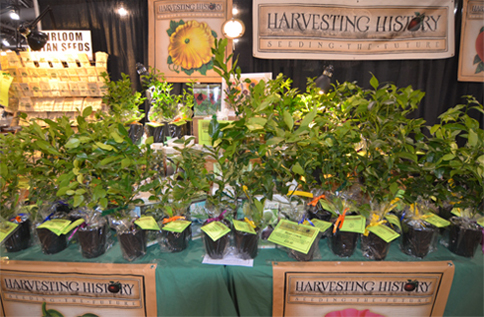 |
|
On Tuesday, we began a newsletter series on garlic which will span 8 newsletters in total, and by the end of this series you will have learned all you ever wanted to know (and then some) about garlic. For those of you who are about to click on the Unsubscribe Button, please don’t! The reason we are dedicating so much writing to garlic is that it can be grown almost anywhere in the US, it is easy, dependable and fascinating to grow, and it is one of the healthiest vegetables you can consume. In grocery stores and health food markets, you can only find a few different kinds of garlic, so it is best to grow your own.
Classifying garlic has been an ongoing battle between taxonomists for centuries. Garlic belongs to the Allium Family, to the Genus Allium and to the Subgenus Allium. As we discussed in the last newsletter, there are fundamentally two kinds of garlic, hardnecks and softnecks. They are also known as bolting (hardnecks) and non-bolting (softnecks), but some hardnecks do not bolt and some softnecks do bolt. The name, garlic, comes from an old Anglo-Saxon word, garleac. Gar meant “spear” and leac meant “leek”. The name referred to the spearlike leaves of the garlic plant.
Today, there are 10 horticultural garlic groups (subspecies) recognized by most (but not all) scientists. They are the following: Artichoke, Asiatic, Creole, Porcelain, Glazed Purple Stripe, Marbled Purple Stripe, Purple Stripe, Rocambole, Silverskin and Turban. The Artichokes, Creoles and Silverskins are softnecks. The Asiatics, Porcelains, Glazed Purple Stripes, Marbled Purple Stripes, Purple Stripes, Rocamboles and Turbans are hardnecks.
The individual who has influenced modern garlic taxonomy the most is an American, Ron Engeland, who organized and described garlic’s taxonomy in his landmark book, Growing Great Garlic: The Definitive Guide for Organic Gardeners and Small Farmers. |
 |
|
|
|
|
The Artichoke Garlic horticultural group belongs to the softnecks. Artichoke garlic cultivars are among the most productive and least problematic of all garlic cultivars. They maure earlier than other garlic cultivars and produce huge bulbs. Best of all, they adapt to a wide range of growing environments, so they can be grown throughout most of the US. Only in Hardiness Zones 1-2 and 8-10 will they have a hard time.
The plants are short, especially for plants that produce such large bulbs. The bulbs are generally flattened, and the cloves are arranged in an overlapping formation that resembles an artichoke – hence the name. The outer cloves are large, but the inner cloves can be quite small. The bulb wrappers and clove wrappers are creamy white to bright white and the clove color is usually creamy white.
Artichoke garlic cultivars do not do well in areas with harsh winters, but they do tolerate climates where the summer temperatures are quite hot.
They store very well.
Red Toch is also known as Tochliavri because in 1988, Peter Hanelt, from the Gatersleben Seed Bank in eastern Germany collected the garlic from a village in the Republic of Georgia named Tochliavri.
This garlic is a standout among the Artichoke Garlics. It has some heat, but not a lot and excellent, but not overpowering flavor and fragrance.
The outer cloves can be very large, and even the inner cloves have good size. I grow this garlic every year. The bulbs are consistently huge and healthy. I love the large cloves. They are easy to cook with. My Red Toch usually produces 10-12 cloves per bulb, but most growers will tell you that 12-18 cloves per bulb is standard.
The bulb wrappers are glistening white, but the clove wrappers are tan with only the subtlest shades of pink or purple. They are beautiful. |
 |
|
|
Don’t miss out on Garlic Bulbs. Buy now!
|
Thermadrone is a very unusual garlic. It was developed by the French for commercial cultivation, but its intense flavor which many describe as (don’t laugh) Dijon mustardy has limited its widespread public appeal. However, in our typically contrarian, American way, we like that unusual Dijon flavor and so Thermadrone has been growing in popularity in the US.
The outer cloves are fairly large, but not as large as Red Toch. The bulbs are large, usually 12-18 cloves, but not as large as Inchie’s bulbs. The bulb wrappers are creamy white and the clove wrappers are tan, sometimes with a blush of pink.
Inchelium Red (pictured at the top of this newsletter), perhaps the best known of the Artichoke garlic cultivars, was originally collected from a garden on the Colville Indian Reservation, near the Canadian Border in Washington State. It was introduced to the American public by the Rodale Kitchens in the late 1980s and early 1990s. It is often, belovedly, referred to as “Inchie”.
The plants produce huge bulbs often with as many as 20 cloves. The flavor is very mild and pleasant when eaten raw. When cooked the flavor maintains its subtlety. |
 |
|
|
|
|
| The Tuesday, July 31, 2018 newsletter will discuss porcelain and Turban Garlics – two of the more exotic hardneck groups grown today. All of the garlic varieties discussed in this newsletter are available on our website. We sell out of garlic quickly, so if you are thinking about ordering, please do it soon. |
 |
|
For our customers in New Jersey, New York, Delaware, Maryland and Connecticut, Harvesting History will have a booth at the New Jersey State Fair and Sussex County Horse Show from August 2- August 12. Come visit us and see what a real old fashion state fair is really like. This is a truly wonderful state fair.
|
|
Celebrate your uniquely American horticultural heritage
Harvest Your History
Seed Your Future
https://www.harvesting-history.com
FREE SHIPPING
on orders $50 and above
Follow us on Instagram
https://www.instagram.com/harvestinghistory
|
 |
|